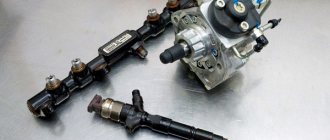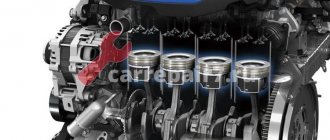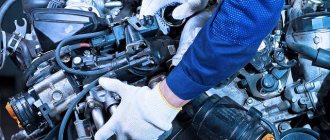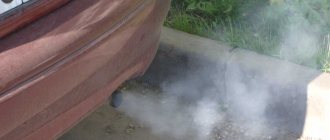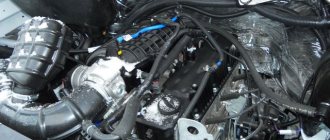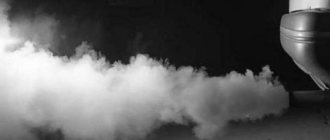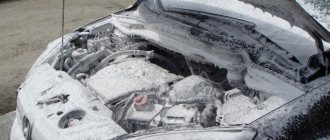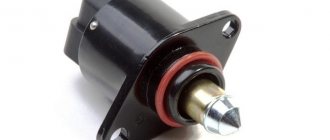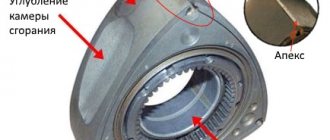Unlike gasoline models, it is much easier to determine the source of the problem in a diesel unit. There are only a few reasons why a diesel engine misfires when cold and smokes white smoke. Finding them will not be difficult, the main thing is to listen carefully to the operation of your car.
When they say that a diesel engine has started to misfire, they mean that one of the cylinders has stopped working. As a rule, all this happens against the background of uncharacteristic noise, vibration, decreased power, as well as clouds of smoke from the car’s muffler.
Such behavior of the unit is fraught not only with increased consumption of diesel fuel, but also with complete breakdown of the motor. Therefore, it is very important to identify and fix the problem in a timely manner. In this article we will deal with the main malfunctions that are accompanied by these symptoms.
Glow plug faulty
Often the solution to the problem lies in the malfunction of the spark plugs, which play an important role in diesel devices. To make the fuel ignite better, the spark plugs heat the internal combustion chamber before starting the diesel engine. And then they maintain the required temperature inside the cylinders until the engine is completely warmed up. Therefore, the easiest way to identify faulty spark plugs is if the diesel engine stops firing after warming up.
When one of the spark plugs does not work at the start of the engine, as a result the thermal regime in the cylinder will be lower than required, which will not allow it to operate normally. Something similar can be observed if there is no voltage supply at the second glow stage of the spark plug. Simply put, the spark plug is not able to provide the temperature necessary for the cylinder to operate.
When checking the spark plug for voltage, pay attention to the integrity of the heated rod. During normal engine operation, the injected jet hits the spark plug and sprays. This helps the fuel mix better with the air and allows the mixture to ignite more easily. If the surface of the heated rod is damaged, mixture formation occurs worse and the diesel engine begins to triple.
Diesel stalls due to a problem with the fuel system
In order for the engine to start working, the fuel must travel from the gas tank to the engine cylinder, passing through the high pressure fuel pump (HPF) and sprayed through the injectors. Each of these stages can create its own problems.
Components of the engine fuel system A common cause of diesel engine throttling is airing of the system; this phenomenon occurs when air gets inside the fuel system. As a result, one of the cylinders does not receive the fuel-air mixture (or receives it with insufficient fuel) and performs its power stroke differently than the others. The reason may be a malfunction of the high pressure fuel pump (HPF), or a leak in the fuel system as a whole.
Lack of compression in a diesel engine
If the spark plugs are in order and the damage has not disappeared, you should take a closer look at the cylinders themselves. It is quite possible that the gaps between individual elements in the piston system of your engine are greatly increased. Increasing the gaps between parts is a natural process when operating a car. But it also affects the compression of the engine cylinders.
Low pressure in the combustion chamber leads to the fact that the incoming fuel is not produced, but is ejected from the cylinder. Most often, the wear of engine parts occurs unevenly; the cylinders begin to operate with different degrees of compression. That's why the diesel engine stalls when cold and produces white smoke.
When warmed up well, the tripping becomes less noticeable or disappears completely, since engine parts tend to expand when heated. To find out whether the cause of tripping is reduced compression, you need to measure the pressure level with a special device - a pressure gauge.
Reasons for tripping of diesel internal combustion engines
It is somewhat easier to answer the question of why a diesel engine is tripping, to determine the causes and to localize the fault compared to gasoline units.
A diesel engine often “troubles” for two main reasons: lack of proper compression of the mixture or problems with fuel supply. It is more difficult to determine the cause if all cylinders are working, but the diesel engine still vibrates and operates erratically. The cause may also be air leaks, problems with sensors, ECU, etc. It is often difficult to quickly find such a malfunction.
The main difference in the operation of a diesel engine is the method of ignition of the fuel-air mixture. Diesel fuel is ignited in the cylinder due to compression. In other words, diesel fuel spontaneously ignites. Additionally, it is necessary to take into account the moment when the “triple motion” of a diesel engine increases. A diesel engine can bleed cold, hot, idling and/or under load. The problem may appear only in a specific narrow speed range, occur periodically, or be present constantly.
Diesel fuel does not ignite: compression is lost
The cylinder-piston group of any internal combustion engine experiences increased loads. During operation, the gaps between the parts of the CPG increase as the elements wear out. The valves of the gas distribution mechanism are also subject to wear.
The loss of the ability to ensure tightness when one of these parts is destroyed leads to the fact that proper heating of the mixture is not ensured during the compression stroke. Diesel fuel simply cannot ignite.
If the compression ratio is insufficient (loss of compression), the diesel engine throttles strongly after a cold start. As a result of heating, the CPG parts expand and the seal in the cylinder increases. A heated diesel engine shakes noticeably less, and the tripping effect may disappear completely. This phenomenon is observed only if there is no critical wear of the CPG or valve mechanism elements.
It turns out that the wear of the cylinder-piston group with engine heating is partially compensated due to the fact that the diesel fuel in the cylinders self-ignites due to an increase in the temperature of the internal combustion engine. There is a situation where a diesel engine misfires after replacing the cylinder head gasket with a new one. In this case, the working unit with a worn-out CPG throttles strongly “on cold” and adjusts “on hot”.
This malfunction is explained by the fact that the new gasket is thicker than the old one. The result is a lower compression ratio, further exacerbating existing compression problems. A thicker gasket affects the efficiency of self-ignition of the working mixture of diesel fuel and air in such an engine.
Diesel misfires due to glow plugs
Glow plugs play an important role in a diesel engine. For a confident start “on cold”, the glow plugs heat the combustion chamber. This is necessary so that self-ignition of the mixture of air and diesel fuel occurs easily during startup. Next, the glow plug continues to maintain the set temperature in the cylinder until the engine finally reaches operating temperature. After this, the candles automatically turn off.
Glow plugs are also indirectly involved in the process of diesel fuel atomization. At the moment of fuel injection, a jet of diesel fuel, which is supplied from a diesel injector under high pressure, hits the heated spark plug. This helps the fuel to be atomized more efficiently in the cylinder.
After contact with the candles, diesel fuel scatters into tiny particles, partially evaporates, and mixes better with the air. As a result, the resulting mixture burns as efficiently as possible, transferring energy to the piston. If the glow plug is faulty, the temperature in the cylinder during a cold start will be too low and the diesel fuel will not be able to self-ignite.
The cylinder will be inoperative, although it will receive fuel, which then enters the exhaust system of the diesel engine. In this case, the diesel engine often produces dark gray or black exhaust. As the temperature of the internal combustion engine increases, the fuel (taking into account normal compression) will begin to ignite, but intermittently. The problem will go away completely after warming up, but with a subsequent cold start the malfunction will recur.
Unstable operation of a diesel engine after partial warming up (provided that the diesel engine worked normally during a cold start) can be explained by the fact that no electric current is supplied to the glow plug in the mode of further maintaining the required temperature in the cylinder. The heating element of the candle (rod) will remain cold, diesel fuel will fall on it, but the quality of the atomization will noticeably decrease. Under such conditions, the mixture formation in the chamber is disrupted, the fuel does not burn completely, the diesel engine smokes and runs hot. In such cases, the glow plugs must be replaced immediately.
Coolant leaking
If the cylinders have lost their seal due to wear or there are gaps between the block and the head gasket, coolant may begin to leak into the combustion chamber. It is easy to guess that this happened from the clouds of white smoke from the diesel exhaust pipe. In this case, the engine can stall both cold and warm.
It should be remembered that after repairing the piston system and replacing the cylinder head gasket, tripping can also be observed when cold. But the fact is that the new gasket may be slightly thicker than the old one. If this happens, the compression level in each cylinder is reduced. Therefore, the fuel mixture in the engine ignites intermittently.
Why does a diesel engine stall when cold and smoke white smoke? - Let's look into the issue
March 31, 2021 Category: Car fault diagnosis
Unlike gasoline models, it is much easier to determine the source of the problem in a diesel unit. There are only a few reasons why a diesel engine misfires when cold and smokes white smoke. Finding them will not be difficult, the main thing is to listen carefully to the operation of your car.
When they say that a diesel engine has started to misfire, they mean that one of the cylinders has stopped working. As a rule, all this happens against the background of uncharacteristic noise, vibration, decreased power, as well as clouds of smoke from the car’s muffler.
Such behavior of the unit is fraught not only with increased consumption of diesel fuel, but also with complete breakdown of the motor. Therefore, it is very important to identify and fix the problem in a timely manner. In this article we will deal with the main malfunctions that are accompanied by these symptoms.
Injector malfunction
It's no secret that the quality of diesel fuel sometimes leaves much to be desired. If the car often runs on low-quality diesel fuel, the service life of the injectors is greatly reduced. Clogged channels are one of the main problems of diesel units. Also, the operation of the injectors is affected by factors such as wear of the nozzle or insufficient pressure of the injection elements.
Due to improper operation of the injectors, little diesel fuel may enter the cylinders, or it will be poorly atomized. In both cases, the combustion process, and therefore the operation of the motor, will be disrupted. And since parts wear unevenly, most often the injectors spray fuel differently. Therefore, the cylinders also do not work the same way. Eventually, the driver will begin to feel the vibration characteristic of a revving engine. Therefore, experienced drivers advise changing diesel injectors every 150 thousand km.
If the engine seizes up, then the only way to identify a non-working injector is by moving it to another cylinder. If after this “manipulation” the cylinder refuses to work, then the problem is in the injector.
Remember that repair or cleaning of injectors in this case must be carried out in conjunction with adjusting the injector and checking the operation of the injection pump.
How to check why white smoke appears?
Gas of this color can come out of the muffler for various reasons, so before starting any repairs, you should accurately determine its cause. You need to start by checking the amount of oil remaining
Pay attention to the color of the liquid to see if an emulsion has appeared. There should be no water in the lubricant, this is extremely harmful to the engine.
If liquid is present, the exhaust will not just become white, but will take on a bluish tone. Its distinctive feature is that it does not dissipate at all, but looks like a foggy cloud behind the car.
Remove the coolant expansion tank cap and see if there is any sediment there. Often a thick film appears there. If you hear a foreign smell, then this is also a bad sign indicating the presence of moisture in the engine.
After unscrewing the spark plug, pay attention to whether it has turned black: if there is carbon deposits, it means that the fuel does not burn completely. The car may not start well, again it’s worth checking the spark plugs; if they are dirty with oil particles or wet, then there is a malfunction in the engine
Paper check
If you have a white napkin or paper sheet, you can do the following test: bring it to the exhaust pipe and hold it for a few seconds, without pressing it close. If there is moisture in the system, the surface will remain white. If there are foreign impurities, its color will change. For example, if there are oily components, greasy stains will remain on the paper; the cooler will turn them blue or yellow, with a pronounced unpleasant aroma.
Check the condition of the gasket and cylinder block. If there are cracks, water gets in through them.
Particular attention should be paid to the surface of the cylinder head. Inspect the inside of the cylinder, the place where the valves are located
Sometimes cracks are not visible visually; for this, a pressure test is performed
However, this must be done with caution; if the block is significantly damaged, a hydraulic shock will occur due to the accumulation of liquid above the pistons
Emulsion on the lid
The smell of exhaust is not always audible in the radiator part; the pressure may remain normal, but coolant enters the engine. You can easily find out about this: white smoke, low fluid level, emulsion traces under the cap of the expansion tank. The coolant enters the engine through the intake system.
You will have to look at the condition of the intake manifold; for this it is not necessary to remove the cylinder head. The causes must be eliminated, otherwise significant damage will be caused to the motor, ranging from problems with constant overheating to more complex breakdowns.
What is the difference between white exhaust and steam?
First of all, you need to understand whether white smoke or simple fumes comes out of the exhaust pipe. With a gasoline engine, steam is not a problem, but if the pipe smokes, you should be wary.
When assessing a problem, first pay attention to the ambient temperature. If the weather is damp, humid, temperature up to +12 degrees, then evaporation will most likely form
In summer it should remain transparent. A diesel engine works in exactly the same way, so there will not be a significant difference in this aspect. The steam does not have a pronounced odor, easily dissipates, does not harm the atmosphere and does not linger in the exhaust system. In turn, the smoky exhaust has a rich white color, it is thick and after exiting it hangs in a dense fog without dissipating immediately. It may have an unpleasant odor.
Incorrect operation of the injection pump
When a diesel engine stalls when cold, you should pay attention to the operation of the high-pressure fuel pump. If the engine starts from a tug, but refuses to run under normal conditions, most likely there is not enough fuel entering the combustion chamber. And this indicates the unsuitability of the injection pump plunger pair. That is, the pump is not able to push fuel through the injectors at the required pressure.
The process of fuel injection pump breakdown is usually quite lengthy. At the very beginning, the engine will simply stall when cold, then it will start from a tug, and then it will refuse to work at all. Therefore, it is necessary to eliminate the breakdown as early as possible. But it is very difficult to prevent such a problem, since in the vast majority of cases the operation of the plunger pair depends on the quality of the fuel, which in our country is of rather low quality.
When inspecting the injection pump, pay attention to the tightness of the pipelines. If the fuel line sucks in air, the engine will stall both cold and hot.
Injection advance
Another problem associated with the operation of the fuel injection pump is injection advance. It is known that the time the fuel spends in the combustion chamber affects the quality of its production. The better the fuel mixture is heated, the higher the efficiency, while the smoky exhaust from your engine becomes minimal. Therefore, some manufacturers deliberately equip diesel engines with heating devices. Thanks to this, the idle speed remains high during a cold start. And the injection accordingly becomes earlier. After warming up, the engine operates as usual.
However, if the injection advance occurs arbitrarily, the engine wears out faster and runs harder. This happens due to the fact that the pressure inside the fuel injection pump does not correspond to the engine speed. There may be several reasons for this problem:
- Stretched belt;
- Clogged fuel filter;
- Wear of the pump itself;
- Pressure reducing valve.
Depending on the cause of the breakdown, injection may be disrupted in a certain speed range or in all of them at once. However, it can be adjusted using the vehicle's operating instructions. But, without knowing the exact cause of the breakdown, it will have to be constantly adjusted. Therefore, it is best to completely inspect the pump and fix the problem, rather than operate a worn injection pump.
If you find that a diesel engine misfires when cold and smokes white smoke somewhere on the road, there is no need to call a tow truck. It is not advisable to drive a faulty engine, but you can get to the workshop or garage on your own. However, you should not delay repairs. Vibration will very quickly damage the engine and instead of just a few parts, you will have to replace the entire engine.
New articles
- The oil pressure light comes on at idle when the engine is warm: why does this happen and what are the dangers?
- Clutch release bearing: signs of malfunction and causes of failure
What to do if the engine stalls: diagnostics and repair
Have you discovered that your engine is misfiring? First of all, it needs to be diagnosed to understand which cylinder is faulty and why.
Of course, there are many reasons why an engine misfires, but you can check most of them yourself in the garage.
You can also go to a car service center, where a technician will diagnose the engine using a computer. Self-checking is allowed, however, when the cylinder does not work due to low compression, you should entrust this work to professionals.
Act one. We identify a non-functioning cylinder.
To carry out diagnostics, the internal combustion engine must be started, which means the check should be carried out carefully. We start the car, the hood must be open. Notice what sounds you hear. Then, one by one, disconnect the high-voltage wires that go to the spark plugs.
When the working cylinder is turned off, the engine revs twice as hard. If the cylinder was not working, the sound of friction will remain the same. If you do not want to disconnect the wires, then one by one you can disconnect the chips that regulate the flow of fuel from the injectors to the cylinders. If you disconnect the chip, and the motor works exactly the same, it means the cylinder is faulty.
Act two. We check high-voltage wires and spark plugs.
To do this, disconnect the wire and inspect it. Is the insulation damaged? This means that the engine is misfiring for this reason.
How to understand the condition of high-voltage wires:
- remove the tip attached to the candle;
- look at the wire, you will see the central core, as well as the tip connecting to the spark plugs. By the way, the tip does not have to be identical to the make and model of your car. After all, its task is to transmit electric current to the candle;
- the core must be tightly connected to the tip. On old wires it oxidizes and does not pass electric current well enough. Due to the high resistance of the wire, the motor oscillates. How to determine what is oxidation? Take the multimeter probe and touch it to the center of the core. During oxidation, the multimeter will not show anything;
- The core may burn out completely. To find the area that is damaged, you will need the tip of a multimeter, which is like a thin needle. Pierce the wire every 0.5–1 cm until you find damage. If the wire is ok, the multimeter will show the proper resistance level. When you come across the damaged area, use a knife to cut off part of the wire. This is the only way to eliminate tripling. If the wire is short, it can be replaced.
Did the check show that the wires are ok? This means that the reason that the engine is misfiring is the spark plugs, which are quite easy to change.
How this procedure is performed:
- Open the hood, there should be no dirt or anything unnecessary.
- Remove the protective cover to get to the spark plugs. Can't remove the protection? Then use an extension cord or adapter. Do not unscrew the spark plugs on a warm engine. The car must cool down.
- Unscrew the spark plugs one by one, disconnecting the wires. To be on the safe side, remove the battery terminals. After all, even if the internal combustion engine is idling, current is still supplied. We must not forget about this when carrying out repair work. To avoid stripping the threads, unscrew the spark plugs carefully. Otherwise, you are guaranteed to incur additional expenses.
- Plug the holes with a clean cloth to prevent anything from getting in there.
- Screw in the candles carefully, first with your hands. This way you will keep the thread intact. When the spark plugs are screwed in, connect the high-voltage wires.
- Flush the engine and make sure it is working properly.
Did you find that the wires and spark plugs are in good condition? Let's start checking the ignition module.
To do this, with the engine running, remove the wires one by one and listen. You may hear a specific sound of the air cushion breaking through between the spark plug and the tip. Have you noticed such sounds from all cylinders? This means that the entire module must be replaced.
Note!
This type of testing can be dangerous. An inexperienced car owner should not carry out such work. After all, you could get an electric shock or damage the internal combustion engine unit. However, this is the only way to perform a test with 100% accuracy and find out why the engine is tripping.
Unable to eliminate tripping? We continue diagnostics.
Act three. We check how much air penetrates into the cylinder.
If it is not enough, the engine also suffers. The air supply system may have become depressurized. To check this, you should shut off the inlet pipe, and then use a compressor to supply air into the cylinder through a vacuum hose; the pressure should be 0.5–0.7 atmospheres. Let's listen. If you hear a hissing sound, there is depressurization.
You can also check the air filter.
It may be clogged and not enough air is flowing in. How to diagnose the throttle sensor and air supply sensor? You will have to connect the ultrabook to a special connector.
Act four. We check whether there is enough fuel entering the cylinder.
To find out, you will have to measure the pressure in the fuel system (up to 7 atmospheres). You will need a special device - a pressure gauge. We connect it to the injector ramp. Diagnostics takes place in 3 steps: while starting the engine, at idle, at operating speed (the tube must be removed from the fuel pressure regulator, and the check valve tube must be pinched).
Have you discovered that your blood pressure is insufficient? This means that the fuel pump is faulty or the pressure valve in the fuel supply system has failed. When the pressure is optimal, you should check the injectors; they may be dirty or need to be replaced. At the end, we diagnose the operation of the fuel system using a special device; most likely, the electronic control unit is functioning with errors.
Act five. We measure the compression in the cylinder using a compression meter.
We connect it to the spark plug hole of the faulty cylinder, start the car, the speed should be high. Record the readings 2-3 times. If you notice that the compression has decreased by 15%, it means that the piston in the cylinder has become unusable, or the valves and piston rings are worn out. In order to accurately determine such a malfunction, disassembling the motor is necessary.
We recommend
“Flushing the engine before changing the oil: weighing the pros and cons” More details The operation of the cylinders depends on the compression. When it is low, the engine stalls.
This happens most often because the o-ring is stuck or the valve is burnt. When the valves on a car are adjusted, it means that the problem is in incorrectly set gaps.
“CHECK” may appear on the instrument panel. This means that the reason that the engine stalls when cold is in itself. To prevent failure of the power unit, the on-board computer reports a problem. To diagnose a car, you should visit a car service center or purchase car paste. It will help increase compression.
Research into the reasons why white smoke appears
If smoke continues to pour out of the chimney after warming up, it is recommended:
- Check the level and condition of the lubricant. To do this, you will need a clean cloth and an oil dipstick. Using a dipstick, the lubricant level is determined. Then a certain amount of oil is applied to the napkin to visually verify compliance with the required parameters. Unacceptable: milky tint, emulsion consistency, presence of coolant, smell of burnt grease. As a result of mixing antifreeze with oil, a light, opaque emulsion is formed. As it circulates through the lubrication system, the resulting substance leaves traces on the cylinder head and filler plug in the form of brown and yellow foam.
- Next, you need to examine the condition of the coolant in the expansion tank for the appearance of an oil film and an unpleasant odor of exhaust gases.
- Inspect the spark plugs, which should not be wet and clean. The absence of carbon deposits on the spark plugs indicates water penetration into the cylinders.
- With the engine running, hold a clean cloth to the exhaust pipe for 3 minutes. Ordinary moisture will not leave a mark on it. Grease spots indicate the presence of oil in the working cylinders. Bluish-yellow traces indicate leakage of coolant, and at the same time there is a distinct acidic odor.
The described signs are indirect evidence of the reasons for the release of white gases. To eliminate the identified defects, you will have to disassemble the engine.
Antifreeze seeps into the cylinders through a thin head gasket or cracks in the body parts: the block, as well as the cylinder head. The presence of damage to the gasket is indicated not only by smoke, but also by factors such as engine tripping.
To determine where coolant leaks occur, it is necessary to examine the block, cylinder head, cylinders, in particular, the places where the valves are located. To search for microcracks, special pressure testing is used.
How to check the injection pump
Incorrect operation of this device may be accompanied not only by black smoke, but associated symptoms include:
- increased fuel consumption;
- unstable idling;
- problems when starting a diesel engine;
- constant overheating;
- drop in power, sluggish acceleration;
- extraneous noise during operation of the power unit.
The best option for checking the performance of the fuel injection pump is to use a stand in an auto repair center. In a garage, you can only partially check the pump:
- To check the plunger pairs of the device, remove the timing belt and slowly rotate the pulley. If you feel variable force, there is no water in the parts. If it is present, the shaft will not rotate, and the pump may jam at startup.
- The pressure in the pump is checked using the RB-4802 tester or another similar device. It is screwed in instead of the fuel pump pipe. The correct readings are 300 kg/sq.m. see, if this is not the case, replace the plunger pair.
- In an electronically controlled motor, the speed sensor may break. In this case, diesel fuel does not enter the cylinders. The sensor is checked with an ohmmeter: infinite resistance indicates a break.
- Another reason for poor fuel injection pump performance is fuel leakage. To check the assumption, start the engine and shake the axis of the device lever. If you see diesel fuel leaking, replace the rubber seal in the problem area.
Blue color of smoke: causes and consequences
Oil getting into the cylinders
In this case, the exhaust takes on different shades of blue: from pale blue to swirling whitish blue. The color of the smoke depends on the operating mode and degree of engine warm-up, as well as the concentration of oil that has entered the cylinders.
A simple test will help you check for oil in the exhaust. With the motor running, cover the pipe with a sheet of paper for a few seconds. If greasy drops appear on it, it means that oil has leaked into the combustion chambers. This is possible if the compression rings are worn out or the cylinder surface is damaged due to abrasive particles. If the car has been parked for a long time, pockets of corrosion may appear on the cylinders and compression rings.
The degree of wear of parts can be determined by the color of the smoke. If the blue color of the exhaust only appears when it warms up, wear is still insignificant. If parts are severely damaged, the smoke only increases.
Sometimes a diesel engine smokes blue smoke due to the fact that the oil scraper rings have lost their springiness. Motorists call this phenomenon stagnation. The rings do not fulfill their intended purpose and oil enters the engine cylinders.
Compression drop
You can diagnose a drop in compression in the cylinders of a diesel engine by the thick black exhaust at startup. A large pressure difference leads to unstable operation of the motor. In cold weather, a unit with weak compression may not start at all - there will not be enough temperature to ignite the fuel mixture.
Another cause of blue smoke is burnout of cylinder valves, accompanied by increased oil consumption. The problem can be easily diagnosed by checking the compression in all cylinders - in the damaged one it will be very low. Burnout of the valves is also indicated by an increase in carbon deposits on the spark plugs.
Sometimes the engine smokes blue due to a ruptured regulator membrane in the automatic transmission. The membrane cavity extends into the intake manifold, and when starting, the engine sucks oil from the automatic transmission.

